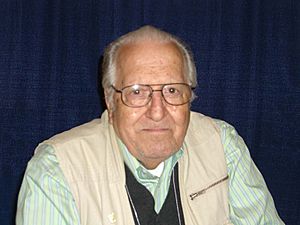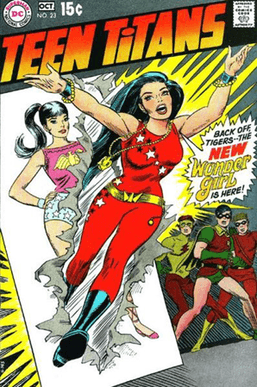Nick Cardy facts for kids
Quick facts for kids Nick Cardy |
|
|---|---|

Nick Cardy at the 2008 New York Comic Con.
|
|
| Born | Nicholas Viscardi October 20, 1920 New York City, New York |
| Died | November 3, 2013 (aged 93) Florida |
| Nationality | American |
| Area(s) | Penciller, Inker |
| Pseudonym(s) | Nick Cardi |
|
Notable works
|
Aquaman Bat Lash Teen Titans |
| Awards | Inkpot Award, 1998 Will Eisner Comic Book Hall of Fame, 2005 |
Nicholas Viscardi (born October 20, 1920 – died November 3, 2013), known as Nick Cardy, was a famous American comics artist. He was best known for his amazing work on DC Comics characters like Aquaman and the Teen Titans. Nick Cardy was even added to the Will Eisner Comic Book Hall of Fame in 2005, which is a huge honor for comic artists!
Contents
Becoming a Comics Artist
Nick Cardy was born Nicholas Viscardi in New York City on October 20, 1920. He started drawing when he was very young. Some of his school paintings were even published in newspapers like the [New York] Herald-Tribune. He also created art for the Boys Club of America. To improve his skills, he studied life drawing at the Art Students League of New York.
Starting in Comics
Like many early comic artists, Cardy began his career at Eisner & Iger. This company, started by Will Eisner and Jerry Iger, created comic books for publishers. Around 1940, Nick joined the studio. He worked on comics like Fight Comics and Jungle Comics.
He also drew a four-page comic called "Lady Luck" for Will Eisner's "The Spirit Section" newspaper comic. Even though these stories were signed with a different name, "Ford Davis," Nick would cleverly hide his own initials, "NV," in each drawing. He used both his birth name and "Nick Cardy" for a while, but eventually stuck with "Nick Cardy" for all his comic book work.
Serving in World War II
From 1943 to 1945, Nick Cardy served in World War II. He was a tank driver in the armored cavalry. He was even awarded two Purple Hearts because he was wounded during his service.
Nick started his Army journey with the 66th Infantry Division. He won a competition to design their patch, creating the cool black panther logo they used. His art talent led him to an office job at the division headquarters. Later, he was assigned to the Third Armored Division. After the war ended, he worked for the Army's Information and Education office in France. Nick drew many detailed sketches and watercolors during his time in the military, showing what he experienced.
Drawing for DC Comics
After the war, Nick Cardy started working in advertising. He also drew covers for magazines. In 1950, he began his long career with DC Comics. He started with the comic book Gang Busters.
Drawing Famous Superheroes
From 1962 to 1968, Nick Cardy drew the first 39 issues of the Aquaman comic book. He also drew all the covers for the series until it ended in 1971. He remembered that the previous artist, Ramona Fradon, was leaving, and he was chosen to take over. Nick's work was so good that when Aquaman got his own comic series, Nick became the main artist.
Some of the Aquaman stories Nick drew included issue #18, which showed Aquaman marrying Mera. He also drew issue #23, where their son was born. Nick Cardy and writer Bob Haney also introduced Aquagirl in issue #33 (June 1967).
Cardy first drew the Teen Titans in The Brave and the Bold #60 (July 1965). In this comic, the superhero sidekicks Robin, Kid Flash, and Aqualad were joined by Wonder Woman's younger sister Wonder Girl. This was Wonder Girl's very first appearance!
After appearing in another comic, the team got their own series with Teen Titans #1 (February 1966). From 1966 to 1973, Cardy drew or inked almost all 43 issues of the series. He helped create new members for the team, like the psychic Lilith Clay and Mal Duncan, with writer Robert Kanigher.
In 1968–69, Cardy also drew a popular but short-lived Western series called Bat Lash. This comic was about a skilled gunslinger who was also a bit of a dandy and wore a flower in his hat. During this time, Cardy also helped his childhood friend, artist Al Plastino, on the Batman newspaper comic strip.
By the early to mid-1970s, Nick Cardy became the main artist for many DC Comics covers.
Later Career and Awards
In the mid-1970s, Cardy left the comic book world. He moved into commercial art, which often paid more. There, he used the name Nick Cardi and created illustrations for magazines and advertisements. He even did art for movie ads, including films like Apocalypse Now (1979).
In 1996, Cardy was one of many artists who worked on Superman: The Wedding Album, a special comic where Superman married Lois Lane. He also contributed to other comics later in his career, like Wonder Woman vol. 2 #120 (April 1997) and the cover of Silver Age: Teen Titans #1 (July 2000).
Awards and Recognition
Nick Cardy received an Inkpot Award in 1998. On July 15, 2005, he was one of four people added to the Will Eisner Comic Book Hall of Fame. This is one of the highest honors for comic book creators.
Besides his art awards, Viscardi also earned two Purple Hearts for his bravery as a tank driver in World War II. He also won a competition to design the patch for the 66th Infantry Division.
Personal Life
After his time in the U.S. Army during World War II, Nick Cardy met and married Ruth Houghby. They had a son named Peter in 1955. Nick and Ruth were married until 1969. Nick Cardy passed away in Florida on November 3, 2013, from congestive heart failure.
Images for kids




